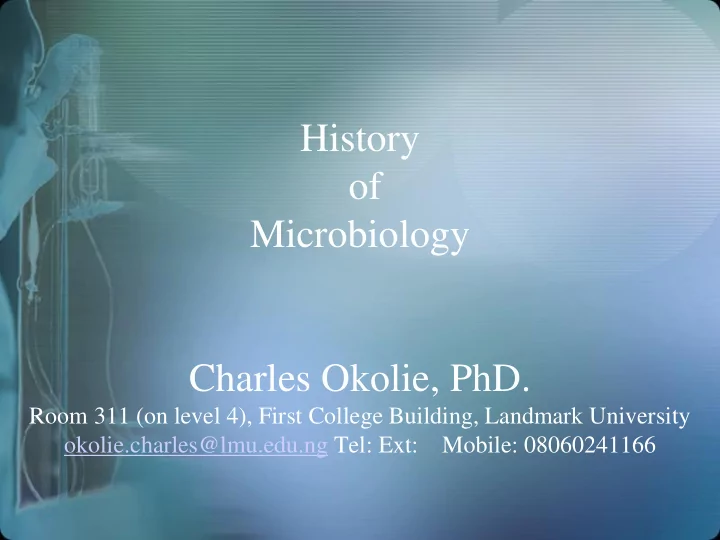

History of Microbiology Charles Okolie, PhD. Room 311 (on level 4), First College Building, Landmark University okolie.charles@lmu.edu.ng Tel: Ext: Mobile: 08060241166
Microbiology - The study of tiny bits of life smaller in size than the unaided eyes can see. Living matter studied in microbiology include: - Bacteria - Algae - Archae - Cyanobacteria - Protozoa - Fungi - Viruses • Most microorganisms (>97% are harmless), a lot of them are actually helpful. • Only very few are harmful (pathogens).
• Aristotle (384-322BC) – Living organisms might have developed from non-living matter (Theory of spontaneous generation). • Roger Bacon – Disease is caused by a minute “SEED” or “GERM” (The germ theory of disease). • One of the major contributions to microbiology was the assembly of pieces of glass by Anton von Leuwenhoek (1632-1723) which he used to examine life unseen to the naked eyes. This invention led to the development of the modern microscope and the scientific method of thinking - curiosity. • Described animalcules in 1676 (bacteria, yeasts, protozoa, and algae) – father of bacteriology and protozoology. • The term microbe was first used by Sedillot in 1878.
• Francesco Redi (1626-1697) – maggots would not arise when meat is covered. • John Needham (1713-1781) – supporter spontaneous generation theory. • - Proposed that tiny organisms (animalcules) arose spontaneously on mutton gravy. • As done by Redi, he covered the flasks with cork, and still the microbes appeared on mutton broth. • Lazzaro Spallanzani (1729-1799) – air carried germs to the culture medium. • Boiled broth would not support the growth of microbes.
• Major twentieth-century events led to the following contributions – Antibiotics – Vaccines – Technology (electron microscope) – MALDI biotyper
• Institution Contributions – Pasteur Institute (France) – Medical Research Council (UK) – CDC-Center for Disease Control and Prevention (USA) – NIH-National Institutes of Health (USA) – WHO-World Health Organization (World – Switzerland) – National Veterinary Research Institute (Nigeria) – National Centre for Biotechnology Information (USA)
• Technological advances have resulted in the development of specialist areas of studies: – Agricultural microbiology – Aquatic microbiology – Industrial microbiology – Medical microbiology – Space microbiology – Environmental microbiology – Molecular microbiology
Likely Examination questions. Questions may come in the examinations with special interest in: • Elie Metchnikoff • Alexander Fleming • Landsteiner & Popper • Loeffler & Frosch • Beijerinck • Ivanovsky • Paul Ehrlich • Robert Koch • Joseph Lister • Louis Pasteur and descendants • Spallanzani • John Needham • Edward Jenner • Animalcules
Further Reading materials available online: • History of Microbiology by R. Parthasarathy. • Microbiology: Introduction & history by Kalpesh Zunjarrao
Nice to meet you. Great microbiologists. Thank you for the opportunity to share.
Recommend
More recommend